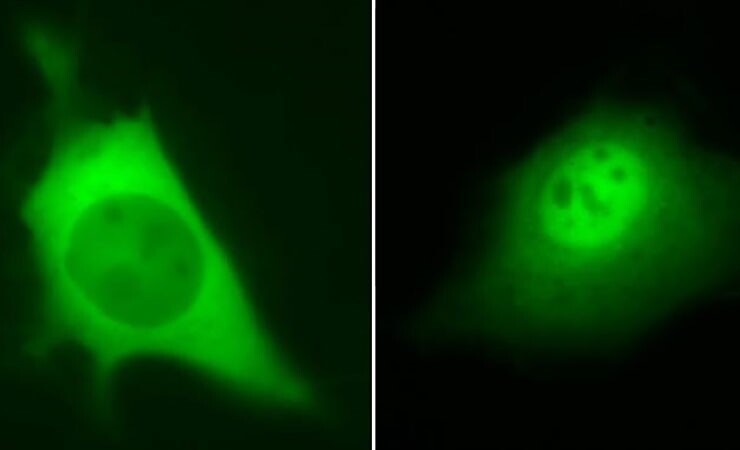
Fluorescence microscopy images depicting how proteins moved into a cell nucleus after irradiiation.
Thomas Weber / Pacific Northwest National Lab

Fluorescence microscopy images depicting how proteins moved into a cell nucleus after irradiiation.
Thomas Weber / Pacific Northwest National Lab
The National Academies held a kickoff meeting
Todd Anderson, director of the Biological Systems Science Division in DOE’s Office of Biological and Environmental Research (BER), explained at the meeting that the department ended the program to focus on higher-priority research and offered ideas about how BER facilities could support a revived program. He also expressed reservations about how low-dose radiation research fits into BER’s current portfolio and how it would fare in the long term if it does not have departmental buy-in.
The study committee is chaired by Joe Gray, a cancer researcher and biomedical engineering professor at Oregon Health and Science University. At the meeting, Gray called the committee’s statement of task
Gray observed that since Congress directed DOE to revive the program, it has provided the department with $5 million annually for its work. He also noted that the Energy Act of 2020 recommends that Congress increase that budget to $40 million annually by fiscal year 2024. House appropriators have proposed BER allocate at least $10 million for low-dose research in fiscal year 2022, while Senate appropriators did not propose a specific amount in their counterpart legislation. BER’s current annual budget
In its first budget request under the Biden administration, DOE did not mention the low-dose program. Discussing the department’s perspective, Anderson stated the “whole reason” the program had been terminated was to free up resources to expand research in bioenergy and environmental processes. He also noted that BER is the department’s hub for climate modeling.
“Those are the topics of the day,” he said.
Prior to the program’s termination, DOE was the federal government’s leading funder of low-dose research. According to a 2017 Government Accountability Office report
Gray pressed Anderson on the advisability of reestablishing the program within BER, saying, “Reading between the lines in some of the things that you said, do you think BER is the right place for this program to be housed? Let’s put you on the spot.”
“I’d have to say I’m not sure,” Anderson replied, and then added,
When I look at the way that our budget language has been structured, the priorities that have been communicated over the last couple of years, I don’t see where low-dose is a priority on the DOE-side. … If Congress puts an entity back into DOE, but there’s no support by DOE or an agency, you’ve got to wonder about the long-term longevity of that program.
Discussing possible priorities for a revived program, Anderson said BER would like to support basic research that reduces uncertainties concerning the validity of the linear no-threshold (LNT) model, which holds there is a proportional relationship between radiation exposure and health risks, even at low doses where effects are difficult to measure. However, Anderson also observed that BER has “almost zero” role to play in setting radiation exposure limits and suggested the committee examine the role of DOE’s Office of Environment, Health, Safety, and Security.
The LNT model is currently used by many government agencies, including the U.S. Nuclear Regulatory Commission, which sets radiation exposure limits for its licensees, and the Environmental Protection Agency, which sets environmental exposure limits.
Much of the data on radiation exposure effects
NRC has stated
Anderson suggested that the study committee consider opportunities for DOE to collaborate with different agencies that have a stake in radiation protection, including NRC and EPA, as well as NASA, which earlier this summer was advised
Anderson also pointed out that BER has already struck up a partnership with NIH’s National Cancer Institute, using the $5 million Congress provided for low-dose research in fiscal year 2021 to fund development of computational tools to detect cancer signatures in large genomic datasets. He suggested the committee consider how the revived DOE program could leverage sequencing capabilities at the Joint Genome Institute in California, as well as other BER-funded capabilities, such as nuclear magnetic resonance and mass-spectrometry instrumentation at Pacific Northwest National Lab.
The study committee will build on the work of a 2019 National Academies symposium that was organized by Gray and gathered perspectives on potential future directions for low-dose research in the U.S. Representatives from several federal science agencies attended the symposium, though none were from BER.
The symposium report
The report also stated that participants in the symposium expressed broad support for re-establishing DOE’s low-dose program, which, it observed “came equally from those who are concerned about the risks at low doses of radiation and those who argue that the risks are currently overestimated and therefore lead to tighter-than-necessary regulations.”
Addressing potential research priorities for a revived low-dose program, the report identified opportunities to expand beyond BER’s past emphasis on radiation biology studies. Among potential options it listed were broadening epidemiological studies of workers exposed to radiation and establishing a research consortium of measurement and computational scientists.
However, the report also noted that a future program “has almost exclusively been thought to follow the same model as the previous DOE-managed program.” It suggested that other governance models could also be used, citing among other possibilities, the multi-agency model of the Cancer Genome Atlas